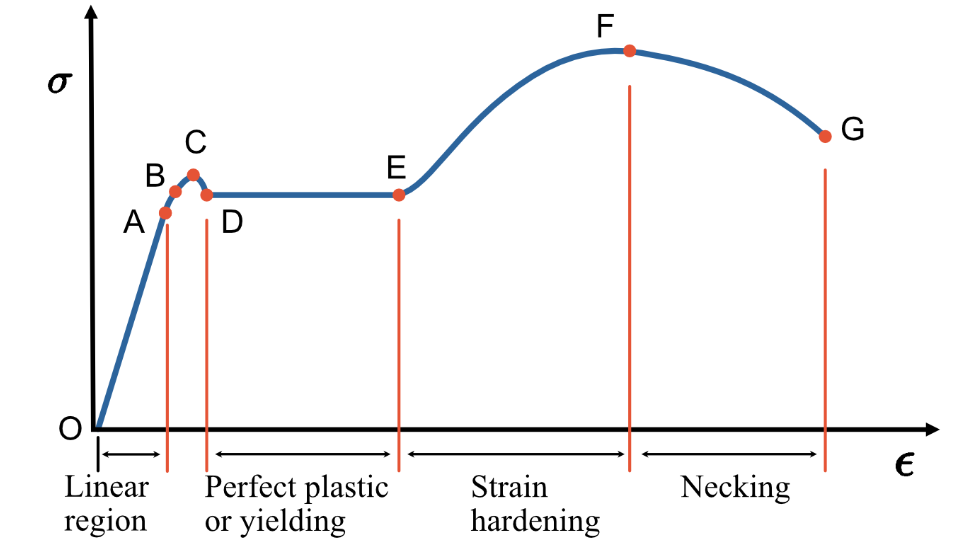We use mild steel in our day-to-day life. It is essential to know how the metal will behave under loading or stretching. We can plot the load-deformation curve to get this understanding. But instead, We plot the stress strain curve as it gives us the required idea about the properties of materials and it is generally independent of the cross-section of the specimen.
The stress strain curve goes through many stages before the specimen experiences failure. All the critical points are marked in the curve as shown below.

The critical points on the stress strain curve:
A: Proportional limit
B: Elastic Limit
C: Upper yield point
D: Lower yield point
E: Beginning of strain hardening
F: Ultimate stress point
G: Fracture Point
Let us take each region of the stress-strain curve and know some key points.
OA region:
- In this region, Stress is directly proportional to the strain.
- Hooks law is valid in this region.
- The slope of the line OA is called the Modulus of Elasticity, and it is constant.
AD region:
- If the bar is unloaded before elastic limit point B, It will instantaneously regain its original shape and dimension.
- The rate of increase of strain is more than that within the proportional limit.
- The upper yield point is the stress level just before yielding starts, and the lower yield point is the stress level at which yield is maintained.
- In this region, the volume of specimens increases and this volume change is associated with normal Stress.
DE region:
- It is called the plastic zone.
- The strain increases with the significant increase in Stress.
- Elongation of the bar is due to the slippage of material on an oblique plane. Hence shear is responsible for the elongation. Elongation due to shear will not lead to any volume change.
- Hence, there is no volume change during plastic deformation.
Note: Shear stress is maximum on the 45-degree plan.
EF region:
- It is the strain-hardening zone.
- In this zone, the material starts offering resistance against deformation. This is because of a change in the crystalline structure of mild steel.
FG region:
- In this zone, Necking happens.
- F is the ultimate stress point.
- Localized instability creeps in, and the cross-section of the specimen at some locations begins to decrease, and ultimately, at G fracture occurs.
Some important points related to the stress strain curve are as follows:
- The percentage reduction in the area of the specimen at the time of fracture is approximately 50%
- For ductile materials like mild steel, shear stress is responsible for failure.
- Shear stress is maximum on the 45 Degree plan, so mild steel experiences cup and cone failure.
- For brittle material, normal stress is responsible

Android Apps
⭐️ ⭐️ ⭐️ ⭐️ ⭐️ 1000+ | 400,000 + Downloads (Cumulative)
At eigenplus, our goal is to teach civil engineering students about structural analysis and design starting from the fundamental principles. We do this with the help of interactive android applications and accompanying web articles and videos.
Our apps have helped more than 400 thousand students across the world to understand and learn the concepts of structural engineering. Check out our apps on the google play store.